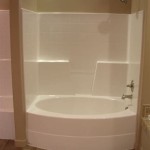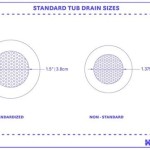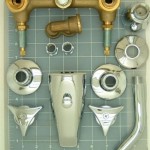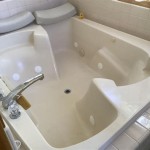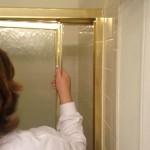How to Remove an Old Bathtub Drain Stopper
Removing an old bathtub drain stopper can often prove a more challenging task than anticipated. Mineral buildup, corrosion, and simple age can all contribute to a stopper becoming firmly lodged within the drain. Successfully removing the stopper requires patience, the appropriate tools, and an understanding of the various stopper mechanisms commonly found in bathtubs. This article provides a comprehensive guide to navigating the process, minimizing the risk of damage to the drain and plumbing.
Prior to initiating any removal attempt, it's crucial to accurately identify the type of drain stopper in place. Different stopper designs necessitate different removal techniques. Common types include lift-and-turn stoppers, pop-up stoppers, toe-touch stoppers, and trip-lever stoppers. Incorrectly identifying the stopper type can lead to ineffective attempts and potential damage to the drain assembly.
Identifying the Type of Bathtub Drain Stopper
Accurately identifying the drain stopper type is the foundation for successful removal. Each type operates on a distinct mechanism, influencing the tools and techniques required for removal. An incorrect identification will almost certainly lead to frustration and potential damage to the drain assembly or the stopper itself.
Lift-and-Turn Stoppers: These stoppers are characterized by a visible knob or handle on the surface of the stopper. The user lifts and turns the knob to engage or disengage the stopper, opening or closing the drain. This mechanism is commonly found in older bathtubs but continues to be utilized in some modern designs. Visual inspection for a central knob that can be lifted and rotated is usually sufficient for identification.
Pop-Up Stoppers: Pop-up stoppers feature a flat, often circular, surface. Pressing down on the stopper engages the mechanism, causing it to seal the drain. Pressing it again releases the seal, allowing water to drain. Distinguishing characteristics include the absence of a visible knob or lever directly on the stopper and the spring-loaded action when pressed.
Toe-Touch Stoppers: Similar in appearance to pop-up stoppers, toe-touch stoppers are activated with a light tap from the foot. The primary difference lies in the internal mechanism and the sensitivity required for activation. While outwardly similar to pop-up stoppers, toe-touch stoppers may exhibit a slightly different feel or response when pressed.
Trip-Lever Stoppers: These stoppers are linked to a lever located on the overflow plate, typically situated beneath the faucet. Moving the lever up or down raises or lowers the stopper, opening or closing the drain. Identifying this type involves locating the lever on the overflow plate and observing its influence on the drain stopper's position.
Once the type of stopper is confidently identified, the appropriate removal strategy can be selected. Attempting to remove a stopper without knowing its mechanism is analogous to attempting to unlock a door without knowing which key to use.
Preparing for Stopper Removal
Preparation is crucial to ensure a smooth and damage-free removal process. Gathering the necessary tools, protecting the bathtub surface, and loosening any potential buildup around the stopper will significantly increase the chances of a successful outcome.
Gathering Necessary Tools: The tools required will vary somewhat depending on the type of stopper. However, some common and generally useful tools include a flathead screwdriver, a Phillips head screwdriver, pliers (preferably needle-nose), a drain stopper removal tool (specifically designed for various stopper types), penetrating oil (e.g., WD-40), cloths or rags, and safety glasses. Having these tools readily available will streamline the process and prevent unnecessary delays.
Protecting the Bathtub Surface: The bathtub's finish is vulnerable to scratches and damage during the removal process. Placing a towel or rubber mat over the drain area will provide essential protection against accidental impacts or scrapes from tools. This preventative measure requires minimal effort but can save time and expense related to bathtub repair.
Loosening Buildup: Mineral deposits, soap scum, and hair often accumulate around the base of the stopper, creating a strong bond that impedes removal. Applying penetrating oil to the area around the stopper and allowing it to soak for at least 15-30 minutes can significantly loosen this buildup. Gently working a thin tool, such as a flathead screwdriver, around the edge of the stopper after the oil has soaked can further break the adhesion.
Careful preparation not only simplifies the removal process but also minimizes the risk of damaging the drain or the bathtub itself. Skipping this step can lead to increased difficulty and potentially costly repairs.
Removing Specific Types of Stoppers
The actual removal process differs considerably depending on the specific type of stopper. Each type requires a targeted approach to disengage its unique mechanism and safely extract it from the drain.
Removing a Lift-and-Turn Stopper: These stoppers typically have a screw located beneath the knob or handle. Use a flathead screwdriver to loosen and remove this screw. Once the screw is removed, the stopper should lift out. If the stopper is still stuck, gently wiggle it while pulling upwards. If resistance persists, apply more penetrating oil and allow it to soak further. In some cases, the entire assembly, including the drain flange, may need to be removed for access to the stopper's connecting mechanism.
Removing a Pop-Up or Toe-Touch Stopper: These stoppers can often be removed by simply twisting and pulling upwards. Applying gentle pressure while turning will often disengage the stopper from its internal threads or locking mechanism. If the stopper doesn't easily release, a specialized drain stopper removal tool may be required. These tools typically have a rubberized tip that provides a secure grip on the stopper. If the stopper is heavily calcified, soaking it in white vinegar for several hours may help dissolve the mineral buildup.
Removing a Trip-Lever Stopper: Removing a trip-lever stopper involves accessing the stopper linkage through the overflow plate. Remove the overflow plate by unscrewing it from the bathtub wall. Use pliers or a screwdriver to disconnect the linkage rod from the stopper. The stopper can then be removed from the drain. This type of stopper is often connected to a complex linkage system, requiring careful observation and documentation (e.g., taking photos) to ensure proper reassembly. If the linkage is corroded or damaged, replacement parts may be required.
Regardless of the stopper type, avoid using excessive force, as this can damage the drain or the stopper itself. Patience and persistence, combined with the appropriate tools and techniques, are essential for a successful removal.
After the stopper is removed, inspect the drain opening for any remaining debris or buildup. Cleaning the drain with a suitable drain cleaner will help prevent future clogs and ensure proper drainage. Reassemble any components that were disassembled during the removal process, taking care to align and tighten screws properly. Finally, test the drain to ensure that it seals and drains correctly. If any issues are encountered, re-examine the assembly and make any necessary adjustments.
Proper safety practices should be observed throughout the removal process. Wearing safety glasses protects the eyes from debris or splashes of chemicals. Using gloves protects the hands from sharp edges or irritants. Working in a well-ventilated area minimizes exposure to fumes from penetrating oils or drain cleaners. Following these safety guidelines will help prevent injuries and ensure a safe and successful outcome.

How To Remove A Bathtub Drain Stopper

How To Remove A Bathtub Drain The Home Depot

How To Remove A Bathtub Drain Forbes Home

How To Remove Bathtub Drain Stopper

How To Replace Bathtub Drain Stopper With A Lift And Turn Diy

How To Remove Bathtub Drain Stopper That Spins Freely

How To Remove A Bathtub Drain The Home Depot

How To Remove Pop Up Tub Stopper Easy Method

How To Replace Bathtub Drain Stopper With A Lift And Turn Diy

How To Remove A Bathtub Drain Stopper
Related Posts

